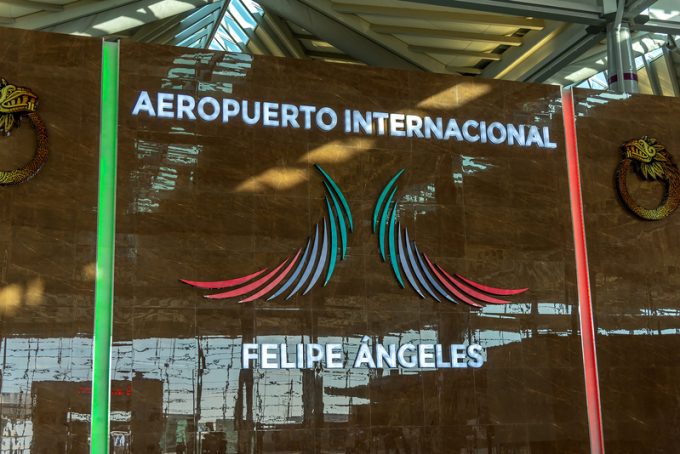Air cargo spot rates hit 2024 peak, while Vietnam becomes a hotspot
Air cargo spot rates have risen to their highest level this year, despite the recent ...
GM: RAISING THE ROOF GGM: IN FULL THROTTLE GZIM: MAERSK BOOST KNIN: READ-ACROSSMAERSK: NOT ENOUGHMAERSK: GUIDANCE UPGRADEZIM: ROLLERCOASTERCAT: HEAVY DUTYMAERSK: CATCHING UP PG: DESTOCKING PATTERNSPG: HEALTH CHECKWTC: THE FALLGXO: DEFENSIVE FWRD: RALLYING ON TAKEOVER TALKODFL: STEADY YIELDVW: NEW MODEL NEEDEDWTC: TAKING PROFIT
GM: RAISING THE ROOF GGM: IN FULL THROTTLE GZIM: MAERSK BOOST KNIN: READ-ACROSSMAERSK: NOT ENOUGHMAERSK: GUIDANCE UPGRADEZIM: ROLLERCOASTERCAT: HEAVY DUTYMAERSK: CATCHING UP PG: DESTOCKING PATTERNSPG: HEALTH CHECKWTC: THE FALLGXO: DEFENSIVE FWRD: RALLYING ON TAKEOVER TALKODFL: STEADY YIELDVW: NEW MODEL NEEDEDWTC: TAKING PROFIT

Freighter operators that made an early shift from Mexico City’s congested Benito Juárez Airport (AICM) to Felipe Angeles (AIFA) have had a turbulent start.
And with almost one-third of all-cargo operators serving the city yet to move to the designated freighter gateway for the Mexican capital before 1 September, there could be further trouble ahead.
By government decree, blaming chronic congestion, no freighters will be permitted at AICM after this month. President López Obrador initially gave carriers only 90 days for the migration, but the deadline has been extended twice.
The majority of the carriers affected moved their all-cargo flights to AIFA in July, and had a torrid time: while the infrastructure at the new airport, completed last year, is a huge improvement over the cargo area at AICM, processes and licences were not fully in place.
Lufthansa Cargo, which runs four freighters a week to Mexico City, had to truck nearly all its maindeck freight (97%) to AICM, which resulted in multiple handling steps and a torrent of e-mail exchanges with customers about the status and whereabouts of their cargo, reported Frank Nozinsky, director Mexico.
“We got washed away by a giant wave,” he said, adding there were multiple issues; for instance, dangerous goods shipments could not be cleared at AIFA, as the customs authority at the site was not ready to process them. But the biggest problem was that customs brokers had not registered at the new airport, which left them unable to perform customs clearance there.
Forwarders and airlines had not been aware of this at the outset. In Mexico, customs brokers deal directly with shippers and consignees, but not with cargo agents. Hence, forwarders had sent cargo to the new airport in anticipation of faster processing, only to face delays after shipments had to make the 50km truck journey back to AICM for clearance.
These problems were compounded by a lack of trucking capacity, said Mr Nozinsky.
Lufthansa Cargo and Air France KLM were the only international carriers with ground handling facilities for both bellyhold and freighter cargo, but the government decree, of course, forced them to split the operations.
“Obviously it’s better to operate in one location, but now we offer our customers a choice to move their shipments through AIFA or through AICM, or they go to AIFA and truck from there to AICM,” explained Mr Nozinsky.
He said he believed ultimately AIFA was the right place for airfreight. The cargo infrastructure at AICM was not only at its limit, but also becoming outdated. After the previous government decided to replace AICM with a new airport – plans abandoned by the current administration when 25% complete – there has been no new investment in the cargo facilities.
Meanwhile, airfreight volumes in Mexico are on the rise, fuelled by investment in new production facilities as part of the growing near-shoring trend. Automotive, historically one of the strong sectors of the Mexican economy, is seeing good growth, but it’s not only for the US, Mr Nozinsky said.
Lufthansa has been moving a lot of cars to Europe, he reported. One current project involves flying about 30 a week.
“The outlook is very positive,” said Mr Nozinsky, adding that Lufthansa is looking at the possibility of adding another freighter frequency as the airline expands its all-cargo fleet.
The carrier should not have major problems handling freight at AIFA, where for LC the situation has been stable for the past couple of weeks.
There are question marks for others, though, notably the freighter operators that have yet to migrate from AICM. While the confusion over customs broker registration should be dying down, there are questions on just how prepared some of the cargo terminals at AIFA are. Some of them have not handled a single shipment so far, noted Mr Nozinsky.
Comment on this article